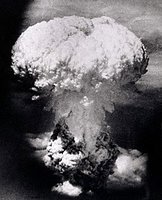Wednesday, August 17, 2005
We Must Act Now to Prevent Another Hiroshima - or Worse
"The probability of apocalypse soon cannot be realistically estimated, but it is surely too high for any sane person to contemplate with equanimity. While speculation is pointless, reaction to the threat of another Hiroshima is definitely not."
Noam Chomsky
READ ME
Noam Chomsky
READ ME
The Yucca Mountain plan, aka "Screw Nevada" bill
"Once nuclear testing went underground in 1963, and American babies stopped having fallout-induced radioactive milk teeth, Nevada fell off the map even as the nuke-a-month program continued unimpeded for almost three more decades."
In an article off Tom Dispatch, Rebecca Solnit links the war in Iraq to the struggle in Neveda, where bombs were tested and spent fuel rods were headed. But the article is mostly about water, gold mining and the Western Shoshone people, who've recently been offered $30,000 each for their chunk of Nevada when Bush signed the Western Shoshone Distribution Bill on July 7, 2004.
In an article off Tom Dispatch, Rebecca Solnit links the war in Iraq to the struggle in Neveda, where bombs were tested and spent fuel rods were headed. But the article is mostly about water, gold mining and the Western Shoshone people, who've recently been offered $30,000 each for their chunk of Nevada when Bush signed the Western Shoshone Distribution Bill on July 7, 2004.
The Union of Concerned Scientists provides a useful clearing house on nuclear weapons policy.
Signatories to a statement opposing resumed nuclear testing include one of the co-discoverers of nuclear energy as the source of the Sun's power, the late Hans Bethe; a nobel-prize winning particle physicist, Steven Weinberg; and Raymond Jeanloz, a professor of Earth and Planetary Science at UC Berkeley.
Signatories to a statement opposing resumed nuclear testing include one of the co-discoverers of nuclear energy as the source of the Sun's power, the late Hans Bethe; a nobel-prize winning particle physicist, Steven Weinberg; and Raymond Jeanloz, a professor of Earth and Planetary Science at UC Berkeley.
Saturday, August 06, 2005
Never Again? How the War in Iraq Spurred a New Nuclear Arms Race

As the world prepares to mark the anniversary of Hiroshima, Iran is poised to go nuclear amid a new global arms race, by Anne Penketh
Tomorrow at 8.15am, a minute's silence will reverberate around the world. The people of Japan will commemorate the victims of the first atomic bomb, which was dropped by an American B-29 on Hiroshima on 6 August 1945.
Half a world away, in Tehran, the new hard man of Iranian politics, President Mahmoud Ahmadinejad, will take the oath of office before the country's parliament. His presidency heralds a new era of uncertainty in Iran's fraught relations with the West over its nuclear ambitions.
In Beijing, urgent talks on curbing North Korea's nuclear weapons program are close to collapse. And in Pakistan, efforts are still being made to roll up the world's biggest nuclear proliferation scandal. Sixty years after Hiroshima, whose single bomb killed 237,062 people, a new nuclear arms race has begun.
the article
Wednesday, August 03, 2005
"The likelihood of a single attack in a single city is greater than ever"

"Little Boy"
Nostalgia is a powerful force when the Cold War is considered the good old days, but this War on Terror is in it's infancy and many folks are expressing a sort of wistfull desire for the simple bianary threat of total anihilation from decades past.
But just one crappy terrorist nuke screwing up a major city - where's the fun in that.
Here's an article from the chron that commemorates the 60th aniversary of the first day of the cold war and then describes why these days we're even worse off...
Of course, there's just a twinge of irrrationalality to the article: suggesting that "suicide bombers" and "terrorists" are scarrier nuke weilding enemies than the rational old days of the cold war.
- Could the Current Israeli Offensive result in Nucl...
- While you were away: The world got creepier
- Arms Control Wonk Says: Enriched Uranium in Iran n...
- "Russians can sleep peacefully through 2040..." Th...
- How Long Until Iran's First Nuclear Bomb: 16 days ...
- U.S. May Nuke the Underground Nuclear Facilities i...
- IRAN: A Picogram of Plutonium or the World's Faste...
- Tritium Spills from Nuke Plants Around the Country
- Berkeley Will Phase out Tritium "EXIT" Signs, the ...
- Kansas Nuke Plant Guards Can Shoot to Kill
- NUCLEAR PHYSICS (just science)
- Nuclear warfare (Wikipedia)
- Nuclear war news (Google)
- Missile Defense news (google)
- Uranium news (google)
- Nuke war papers (Google Scholar)
- International Atomic Energy Agency
- Center for Strategic and International Studies
- U.S. Department of Defense
- Nuclear Regulatory Commission
- Bulletin of the Atomic Scientists
- Federation of American Scientists
- International Physicians for the Prevention of Nuclear War
- Radiation and Public Health Project -authors of the Tooth Fairy Project
- Natural Resources Defense Council
- Nuclear Age Peace Foundation
- TJ's Global Nuclear Explosions Database
- Nevada Test Site Kids Zone
- globalsecurity.org
- antiwar.com
- ArmsControlWonk.com
- NEI Nuclear NotesPro Nuke Power Blog
- Google Earth
- Google Blog Search

 UPSHOT-KNOTHOLE - This operation conducted at the Nevada Test Site consisted of 11 atmospheric tests. There were three airdrops, seven tower tests, and one airburst. Conducted between March 17 and June 4, 1953, this operation involved the testing of new theories, using both fission and fusion devices.
UPSHOT-KNOTHOLE - This operation conducted at the Nevada Test Site consisted of 11 atmospheric tests. There were three airdrops, seven tower tests, and one airburst. Conducted between March 17 and June 4, 1953, this operation involved the testing of new theories, using both fission and fusion devices.